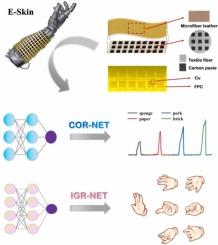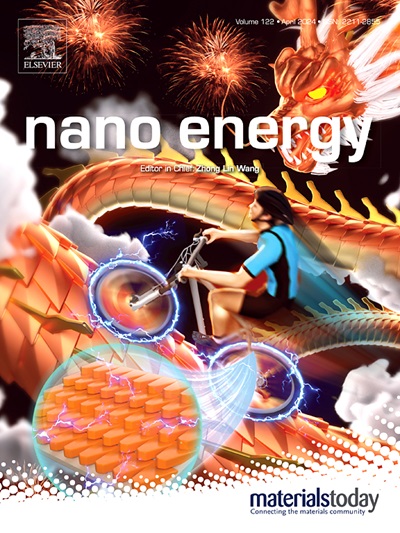用于机器人交互皮肤的皮革印刷触觉传感器阵列
IF 16.8
1区 材料科学
Q1 CHEMISTRY, PHYSICAL
引用次数: 0
摘要
触觉是机器人与人类和环境交互的重要界面,能够感知物体属性、人类交互意图以及撞击和碰撞风险。为了应对这些交互挑战,阵列式电子皮肤需要具备更高的性能,如皮肤般的柔韧性、大面积低成本制造,更重要的是更宽的范围、更高的线性度和一致性。在此,我们开发了一种皮革表面丝网印刷技术来制造柔性纤维网络压力传感器阵列。这种多层三维导电力敏网络具有超宽量程(0-4.5 兆帕)、高线性度(99.3%)和高一致性(99.98%)等优异性能。这种基于皮革的触觉装置可以方便地贴合到机器人的表面。此外,以四元卷积神经网络(Tet-Net Convolutional Neural Network)为骨干网络,结合深度可分离卷积、多尺度模块、非对称卷积等技术,建立了基于注意力机制的接触物体识别残差网络(COR-Net)和交互手势识别残差网络(IGR-Net),成功识别不同物体的硬度材料,用于碰撞预警和判断人机交互意图,准确率分别达到95%和98.48%。机器人可以根据人机交互意图完成物体抓取、搬运等操作。这项研究展示了柔性印刷皮革装置在人机交互领域的巨大应用潜力。本文章由计算机程序翻译,如有差异,请以英文原文为准。

Leather-based printed tactile sensor array for robotic interactive skin
Tactile sensation serves as a crucial interface for robots to interact with humans and the environment, enabling the perception of object properties, human interaction intentions, and risks of impact and collision. In order to meet these interactive challenges, an array-type electronic skin need to possess higher performances, such as skin-like flexibility, large-area low-cost fabrication, and more importantly, wider range, higher linearity and consistency. Here, we developed a leather surface screen printing technology to fabricate a flexible fiber network pressure sensor array. The multi-layered three-dimensional conductive force-sensitive network exhibits excellent performance such as an ultra-wide range (0–4.5 MPa), high linearity (99.3 %), and high consistency (99.98 %). This leather-based tactile device could be easy to conformally attach onto the surface of robots. Additionally, using Tet-Net Convolutional Neural Network as the backbone network, combined with depthwise separable convolution, multi-scale modules, asymmetric convolutions, etc., we established a Contact Object Recognition Residual Network (COR-Net) and an Interaction Gesture Recognition Residual Network (IGR-Net) based on the attention mechanism to successfully recognize the hardness material of different objects for collision warning and judge human interaction intentions, with accuracy rates of 95 % and 98.48 %. Robots can complete object grasping, handling, and other operations according to human interaction intentions. This study exhibits the significant application potential of flexible printed leather devices in the field of human-robot interaction.
求助全文
通过发布文献求助,成功后即可免费获取论文全文。
去求助
来源期刊

Nano Energy
CHEMISTRY, PHYSICAL-NANOSCIENCE & NANOTECHNOLOGY
CiteScore
30.30
自引率
7.40%
发文量
1207
审稿时长
23 days
期刊介绍:
Nano Energy is a multidisciplinary, rapid-publication forum of original peer-reviewed contributions on the science and engineering of nanomaterials and nanodevices used in all forms of energy harvesting, conversion, storage, utilization and policy. Through its mixture of articles, reviews, communications, research news, and information on key developments, Nano Energy provides a comprehensive coverage of this exciting and dynamic field which joins nanoscience and nanotechnology with energy science. The journal is relevant to all those who are interested in nanomaterials solutions to the energy problem.
Nano Energy publishes original experimental and theoretical research on all aspects of energy-related research which utilizes nanomaterials and nanotechnology. Manuscripts of four types are considered: review articles which inform readers of the latest research and advances in energy science; rapid communications which feature exciting research breakthroughs in the field; full-length articles which report comprehensive research developments; and news and opinions which comment on topical issues or express views on the developments in related fields.
 求助内容:
求助内容: 应助结果提醒方式:
应助结果提醒方式:


